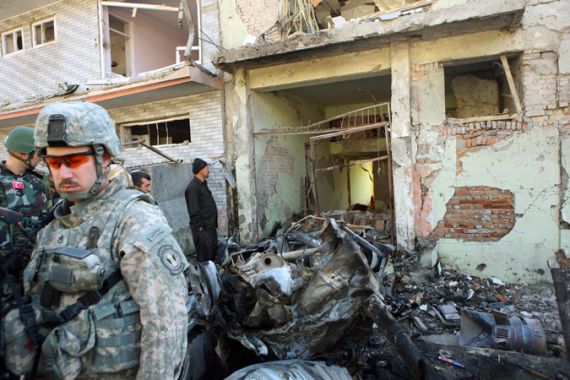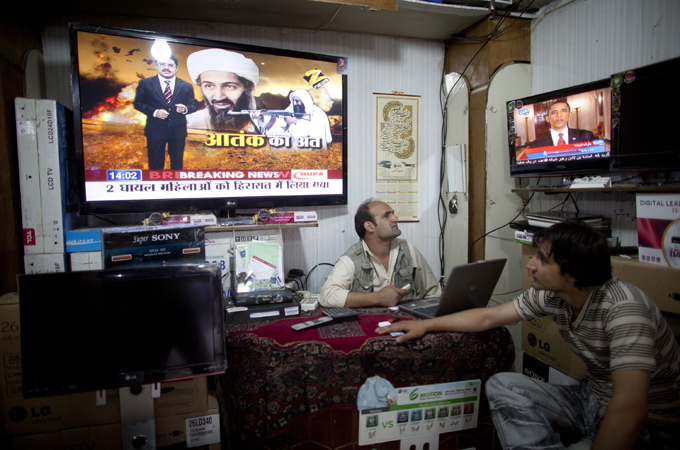US-NATO war ‘served al-Qaeda strategy’
Slain journalist Syed Saleem Shahzad’s book asserts al-Qaeda, unlike the Taliban, wants Western-led wars to continue.

 |
| According to Shahzad’s book, bin Laden was simply a “figurehead” for al-Qaeda while Dr Ayman Zawahiri formulated the group’s ideology and operational plans [GALLO/GETTY] |
Al-Qaeda strategists have been assisting the Taliban fight against US-NATO forces in Afghanistan because they believe that foreign occupation has been the biggest factor in generating Muslim support for uprisings against their governments, according to the just-published book by Syed Saleem Shahzad, the Pakistani journalist whose body was found in a canal outside Islamabad last week with evidence of having been tortured.
That al-Qaeda view of the US-NATO war in Afghanistan, which Shahzad writes about in the book based on conversations with several senior al-Qaeda commanders, represents the most authoritative picture of the organisation’s thinking available to the public.
Shahzad’s book “Inside al-Qaeda and the Taliban” was published on May 24 – only three days before he went missing from Islamabad on his way to a television interview. His body was found May 31.
Shahzad, who had been the Pakistan bureau chief for the Hong Kong-based Asia Times, had unique access to senior al-Qaeda commanders and cadres, as well as those of the Afghan Taliban and the Pakistani Taliban organisations. His account of al-Qaeda strategy is particularly valuable because of the overall ideological system and strategic thinking that emerged from many encounters Shahzad had with senior officials over several years.
Shahzad’s account reveals that Osama bin Laden was a “figurehead” for public consumption, and that it was Dr Ayman Zawahiri who formulated the organisation’s ideological line and devised operational plans.
Shahzad summarises al-Qaeda’s strategy as being to “win the war against the West in Afghanistan” before shifting the struggle to Central Asia and Bangladesh. He credits al-Qaeda and its militant allies in North and South Waziristan with having transformed the tribal areas of Pakistan into the main strategic base for the Taliban resistance to US-NATO forces.
But Shahzad’s account makes it clear that the real objective of al-Qaeda in strengthening the Taliban struggle against US-NATO forces in Afghanistan was to continue the US-NATO occupation as an indispensable condition for the success of al-Qaeda’s global strategy of polarising the Islamic world.
Shahzad writes that al-Qaeda strategists believed its terrorist attacks on 9/11 would lead to a US invasion of Afghanistan which would in turn cause a worldwide “Muslim backlash”. That “backlash” was particularly important to what emerges in Shahzad’s account as the primary al-Qaeda aim of stimulating revolts against regimes in Muslim countries.
Shahzad reveals that the strategy behind the 9/11 terrorist attacks and the large al-Qaeda ambitions to reshape the Muslim world came from Zawahiri’s “Egyptian camp” within al-Qaeda. That group, under Zawahiri’s leadership, had already settled on a strategic vision by the mid-1990s, according to Shahzad.
The Zawahiri group’s strategy, according to Shahzad, was to “speak out against corrupt and despotic Muslim governments and make them targets, to destroy their image in the eyes of the common people”. But they would do so by linking those regimes to the United States.
In a 2004 interview cited by Shahzad, one of bin Laden’s reported collaborators, Saudi opposition leader Saad al Faqih, said Zawahiri had convinced bin Laden in the late 1990s that he had to play on the US “cowboy” mentality that would elevate him into an “implacable enemy” and “produce the Muslim longing for a leader who could successfully challenge the West”.
Playing into al-Qaeda’s hands
Shahzad makes it clear that the US occupations of Afghanistan and Iraq were the biggest break al-Qaeda had ever gotten. Muslim religious scholars had issued decrees for the defence of Muslim lands against the non-Muslim occupiers on many occasions before the US-NATO war in Afghanistan, Shahzad points out. But once such religious decrees were extended to Afghanistan, Zawahiri could exploit the issue of the US occupation of Muslim lands to organise a worldwide “Muslim insurgency”. That strategy depended on being able to provoke discord within societies by discrediting regimes throughout the Muslim world as not being truly Muslim.
Shahzad writes that al-Qaeda strategists became aware that Muslim regimes – particularly in Saudi Arabia – had become active in trying to end the wars in Iraq and Afghanistan by 2007, because they feared that as long as they continued “there was no way of stopping Islamist revolts and rebellions in Muslim countries”.
What al-Qaeda leaders feared most, as Shahzad’s account makes clear, was any move by the Taliban toward a possible negotiated settlement – even based on the complete withdrawal of US troops. Al-Qaeda strategists portrayed the first “dialogue” with the Afghan Taliban sponsored by the Saudi king in 2008 as an extremely dangerous US plot – a view scarcely supported by the evidence from the US side.
Shahzad’s book confirms previous evidence of fundamental strategic differences between Taliban leadership and al-Qaeda.
Those differences surfaced in 2005, when Mullah Omar sent a message to all factions in North and South Waziristan to abandon all other activities and join forces with the Taliban in Afghanistan. And when al-Qaeda declared its campaign against the Pakistani state in 2007, Omar opposed that strategy, even though it was ostensibly aimed at deterring US attacks on the Taliban.
Shahzad reported that al-Qaeda created the Pakistani Taliban in early 2008, to “draw the Afghan Taliban away from Mullah Omar’s influence”.
The Shahzad account refutes the official US military rationale for the war in Afghanistan, which is based on the presumption that al-Qaeda was primarily interested in getting the US and NATO forces out of Afghanistan and that the Taliban and al-Qaeda are locked in a tight ideological and strategic embrace.
Shahzad’s account shows that despite cooperative relations with Pakistan’s ISI in the past, al-Qaeda leaders decided after 9/11 that the Pakistani military would inevitably become a full partner in the US “war on terror” and would turn against al-Qaeda.
The relationship did not dissolve immediately after the terror attacks, according to Shahzad. He writes that ISI chief Mehmood Ahmed assured al-Qaeda when he visited Kandahar in September 2001 that the Pakistani military would not attack al-Qaeda as long it didn’t attack the military.
He also reports that Pakistani president Pervez Musharraf held a series of meetings with several top religious leaders and asked them “to lie low for five years”, arguing that the situation could change after that period. According to Shahzad’s account, al-Qaeda did not at the beginning intend to launch a campaign against Pakistan’s military but was left with no other option when the Pakistani military sided with the US.
The major turning point was an October 2003 Pakistani military helicopter attack in North Waziristan which killed many militants. In apparent retaliation in December 2003, there were two attempts on Musharraf’s life, both organised by a fighter whom Shahzad says was collaborating closely with al-Qaeda.
In his last interview with The Real News Network, however, Shahzad appeared to contradict that account, reporting that the ISI had wrongly told Musharraf that al-Qaeda was behind the attempts, and even that there was some Pakistani Air Force involvement in the plot.
A version of this article first appeared on Inter Press Service news agency.